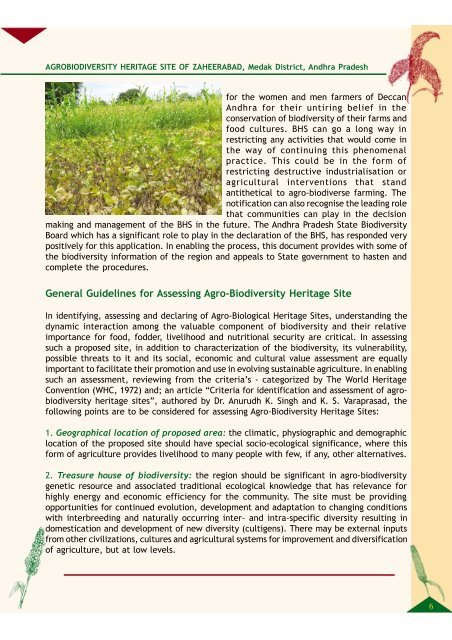Click for details - Deccan Development Society
Click for details - Deccan Development Society
Click for details - Deccan Development Society
Create successful ePaper yourself
Turn your PDF publications into a flip-book with our unique Google optimized e-Paper software.
AGROBIODIVERSITY HERITAGE SITE OF ZAHEERABAD, Medak District, Andhra Pradesh<br />
<strong>for</strong> the women and men farmers of <strong>Deccan</strong><br />
Andhra <strong>for</strong> their untiring belief in the<br />
conservation of biodiversity of their farms and<br />
food cultures. BHS can go a long way in<br />
restricting any activities that would come in<br />
the way of continuing this phenomenal<br />
practice. This could be in the <strong>for</strong>m of<br />
restricting destructive industrialisation or<br />
agricultural interventions that stand<br />
antithetical to agro-biodiverse farming. The<br />
notification can also recognise the leading role<br />
that communities can play in the decision<br />
making and management of the BHS in the future. The Andhra Pradesh State Biodiversity<br />
Board which has a significant role to play in the declaration of the BHS, has responded very<br />
positively <strong>for</strong> this application. In enabling the process, this document provides with some of<br />
the biodiversity in<strong>for</strong>mation of the region and appeals to State government to hasten and<br />
complete the procedures.<br />
General Guidelines <strong>for</strong> Assessing Agro-Biodiversity Heritage Site<br />
In identifying, assessing and declaring of Agro-Biological Heritage Sites, understanding the<br />
dynamic interaction among the valuable component of biodiversity and their relative<br />
importance <strong>for</strong> food, fodder, livelihood and nutritional security are critical. In assessing<br />
such a proposed site, in addition to characterization of the biodiversity, its vulnerability,<br />
possible threats to it and its social, economic and cultural value assessment are equally<br />
important to facilitate their promotion and use in evolving sustainable agriculture. In enabling<br />
such an assessment, reviewing from the criteria’s - categorized by The World Heritage<br />
Convention (WHC, 1972) and; an article “Criteria <strong>for</strong> identification and assessment of agrobiodiversity<br />
heritage sites”, authored by Dr. Anurudh K. Singh and K. S. Varaprasad, the<br />
following points are to be considered <strong>for</strong> assessing Agro-Biodiversity Heritage Sites:<br />
1. Geographical location of proposed area: the climatic, physiographic and demographic<br />
location of the proposed site should have special socio-ecological significance, where this<br />
<strong>for</strong>m of agriculture provides livelihood to many people with few, if any, other alternatives.<br />
2. Treasure house of biodiversity: the region should be significant in agro-biodiversity<br />
genetic resource and associated traditional ecological knowledge that has relevance <strong>for</strong><br />
highly energy and economic efficiency <strong>for</strong> the community. The site must be providing<br />
opportunities <strong>for</strong> continued evolution, development and adaptation to changing conditions<br />
with interbreeding and naturally occurring inter- and intra-specific diversity resulting in<br />
domestication and development of new diversity (cultigens). There may be external inputs<br />
from other civilizations, cultures and agricultural systems <strong>for</strong> improvement and diversification<br />
of agriculture, but at low levels.<br />
6


